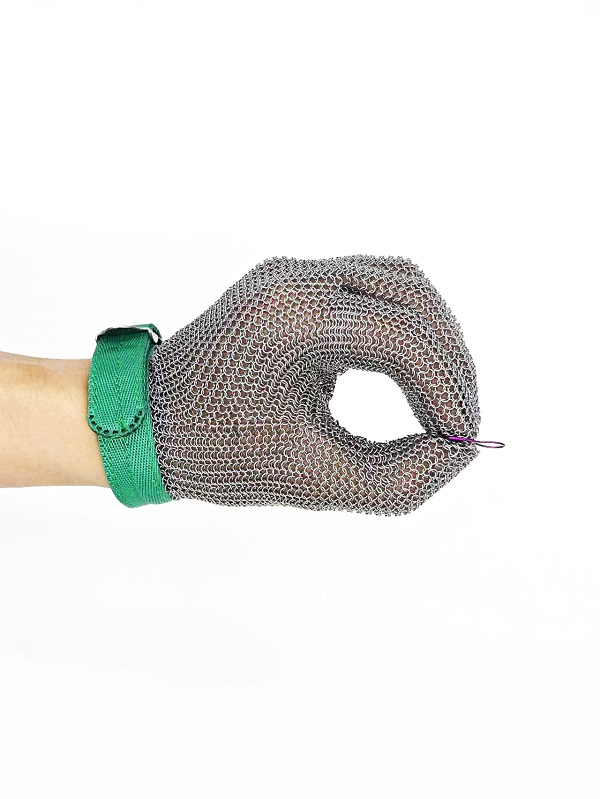


When handling sharp objects like knives, metal edges, or glass, preventing severe hand injuries is paramount. Stainless steel mesh hand gloves are specifically engineered to offer high levels of cut resistance, making them a critical safety component in many industries. Let's explore how they provide this essential protection.

The core protective element of these gloves is a flexible fabric woven from thousands of interlocking stainless steel rings. This unique metal mesh construction works to protect hands through two primary mechanisms:
Deflection: The hard, smooth surface of the steel rings causes sharp edges (like a knife blade or metal burr) to glance off or slide across the surface, rather than biting into the material.
Energy Absorption & Distribution: When force is applied, the mesh structure deforms slightly, absorbing impact energy and distributing the cutting or slicing force across multiple interconnected rings. This significantly reduces the point pressure on any single ring, preventing penetration.
Not all stainless steel mesh cut resistant gloves offer the same level of protection. Performance depends on:
Ring Diameter & Wire Gauge: Smaller rings and thicker gauge wire generally enhance cut protection by creating a denser, more robust barrier.
Material Grade: 304 stainless steel mesh provides excellent general cut resistance. For environments requiring enhanced durability or corrosion resistance (which can indirectly affect long-term cut protection), 316L stainless steel mesh is often used.
Material Integrity: High-quality, consistently welded rings are crucial. Weak welds or inconsistent ring size create potential failure points.
Testing & Certification: Reputable manufacturers like RETON ensure their cut resistant safety gloves meet or exceed recognized international standards such as:
EN 388:2016: Measures resistance to abrasion, cut (by circular blade), tear, and puncture. The cut resistance is rated from Level A (lowest) to F (highest). Stainless mesh gloves typically achieve high levels (e.g., Level D, E, or F).
ASTM F2992/F2992M: Standard test method for measuring cut resistance of materials using a Tomodynamometer (TDM-100) test machine. Results are given in grams of load required to cut through the material.
ANSI/ISEA 105: American standard grading cut resistance on a scale from A1 to A9.
Stainless steel mesh cut resistant gloves are indispensable in numerous high-risk sectors:
Meat and Poultry Processing: Protecting workers during boning, trimming, and cutting operations.
Metal Fabrication & Stamping: Handling sharp sheet metal, stamping parts, or deburring.
Glass Manufacturing & Handling: Cutting, shaping, handling broken glass, and installation.
Recycling & Waste Management: Sorting materials, handling sharp scrap metal, or e-waste.
Landscape Maintenance: Pruning, trimming thorny bushes, and using sharp tools.
RETON designs and manufactures stainless steel mesh hand gloves prioritizing genuine cut resistance backed by relevant safety certifications. Our focus is on:
Consistent Quality: Using high-grade stainless steel (304 or 316L) and precise welding techniques.
Tested Performance: Ensuring gloves meet stringent standards like EN 388 and ASTM F2992 for verifiable cut protection.
Appropriate Options: Offering different models (e.g., standard mesh, coated mesh, or Kevlar-lined mesh) to match specific cut hazards and environmental conditions (like exposure to moisture or oils).
Safety Note: While offering exceptional cut resistance, stainless steel mesh gloves are primarily designed for cut and puncture hazards. They are not electrically insulating and may not be suitable for all chemical exposures. Always assess the full range of workplace hazards.
For detailed information on RETON's cut resistant stainless steel mesh hand gloves, including specific certification levels (EN 388 Cut Level, ASTM F2992 grams) and suitability for your application:
Visit RETON's Website: Explore our range: https://www.rt-ringmesh.com/
Contact RETON Sales: Email sales@rt-ringmesh.com for technical specifications, test reports, or assistance in selecting gloves with the required cut resistance level.
Investing in properly certified stainless steel mesh cut resistant gloves is a fundamental step towards effective hand safety programs in hazardous cutting environments.
Hot tag:
Stainless steel mesh hand gloves
Cut resistance / Cut resistant
Stainless steel mesh cut resistant gloves
Metal mesh construction
Stainless steel rings
Cut protection
304 stainless steel mesh
316L stainless steel mesh
Cut resistant safety gloves
EN 388 (Cut Level)
ASTM F2992
ANSI/ISEA 105
Cut resistance level
High levels of cut resistance
Verifiable cut protection
RETON stainless steel mesh gloves